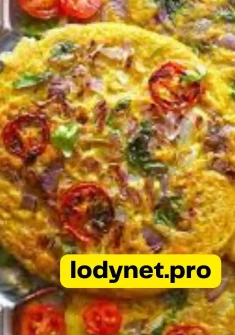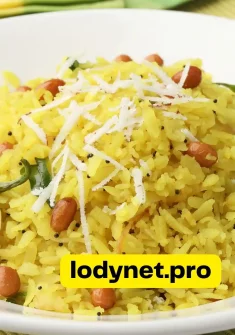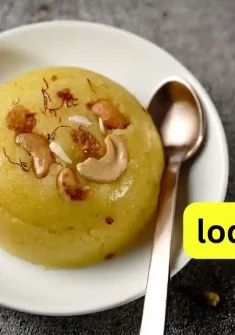The Upma recipe is simple to follow directions . Also referred to as Rava Upma, it is a simple Indian breakfast composed of semolina and whole-tempering spices as well as curry leaves, nuts and. It’s a common staple and the most common food served at South Indian homes, restaurants, and tiffin centers. If you’re a novice or have a long-standing cooking experience, the recipe below will assist cook the perfect Upma in the comfort of your home.

The best Upma is tasty, soft, and non-sticky, bursting with flavors from ginger, curry leaves, mustard, green chilies roasting lentils, and cumin seeds. This delicious recipe requires easy and doesn’t require any special skills. It is the most simple recipe you can cook in just 20 minutes.
If you’re unfamiliar with Indian food and are wondering about what exactly is Upma?
About Rava Upma
It is a typical South Indian breakfast food that is prepared by simmering the roasted rava over hot water that has been spiced and tempered. Rava refers to a South Indian word for ‘semolina and is called Rava Upma.
It is traditionally made from grains of coarse ground rice or wheat; however, nowadays, we mix it with different ingredients, including oats poha, vermicelli, and quinoa, among others.
The recipe for this upma follows the tradition of preparing it. The semolina is dry-roasted until it becomes crispy. Then a tempering recipe is created by using spices like the chana dal, the urad dal as well, as curry leaves.
Onions are cooked in the tempering, and then enough water is added to make the spiced blend. Finally, the roasted rava gets incorporated slowly into boiling hot water. The made-upma is cooked and smooth, without any lumps.
Cashews, peanuts, mixed vegetables, Ghee, etc., can also be used as an option to improve the flavor of the rava utma. Fruits and vegetables like peas, carrots, and beans may also be added to boost the nutritional quality of the dish.
It is typically eaten together with the peanut podi or idli Podi, coconut chutney, or served with pickle. The majority of people serve it to children with a sprinkle of Ghee and sugar on top of it to soften the heat of the chilies.
The choice of a good quality rava is crucial to making the best upma. It’s readily available in Indian markets. Making rava upma can be simple if you have a rava pre-roasted. Because it has already been roasted so the cooking time of your meal will decrease. There are a few options available when purchasing the rava
Double-roasted Rava: DRR offers a longer shelf-life and flavor than the normal Rava. It’s pre-roasted by the manufacturer, making it possible to use it straight in your recipe. It makes for a soft and smooth upma. There isn’t any organic double-roasted rava that is organic on the shelves at any point. Therefore it’s an ordinary one.
Single Roast Rava (roasted the rava): This kind of rava is lightly roasted and usually doesn’t create the greatest upma. I like roasting single-roasted rava because it doesn’t give me the same results as double-roasted. There is also organic roasted rava, which is typically single-roasted.
Unroasted Rava:As the name implies, it’s just semolina which isn’t roasted. You have to roast it. Rava, which is organic and available in the market, is not roasted. That is the method I employed in this blog post.
I roast the whole package of semolina once I open it. Then cool it down completely and then store it in a dry airtight container. This will reduce your roasting time when you need to prepare upma. Additionally, this process helps keep your semolina fresh longer.
Howto make Upma?
Preparation
- Clean 1 cup semolina (Bombay rava). Put it into a skillet and bake at a medium to low temperature until it becomes crispy. Make sure to stir it frequently so that it doesn’t discolor. It is not a good idea for the rava to turn brown. If you’re roasting semolina twice, the roasting process takes only one time of about a minute. Once it’s crunchy, set aside for cooling.
- As you cook the rava, make these items:
- 1 tiny onion (slice or chop finely)
- 1/2 inch of ginger ( 1/2-3/4 teaspoon finely chopped)
- 1 to 2 chilies (chopped or cut)
- 1 sprig of curry leaves (rinse and dry thoroughly to prevent splashes)
- If you prefer to include vegetables, you can include 1/4 cup of green peas and 1/4 cup finely chopped carrots and two French beans. Be sure to chop them finely; otherwise, they will not cook properly.
- For tempering, you’ll need
- 1 teaspoon mustard seeds
- 1/2 teaspoon cumin seeds (Jeera, optional)
- 1 teaspoon of urad Dal (skinned whole, black gram, or cut in half)
- 1 1/2 teaspoon chana dal (bengal gram)
- 2 tablespoons of peanuts (optional Raw or cooked)
- Up to 12 whole cashews (split the cashews, but you can remove them if you are using peanuts)
- Peanuts are not required and can be used if you need a kick in your pop. At a moderate temperature, cook the raw peanuts with 1 teaspoon of oil until they are deep golden and fragrant but not burned. Then transfer to a plate and reserve to decorate. Don’t bother with this step if you’re roasting peanuts.
Temper Spices
- 2. Add 2 tablespoons of oil in the hot pan. Once the oil is hot, add cumin seeds and mustard seeds if they are used. As the seeds begin to splutter in the oil, add urad dal and chana dal.
- Cook them until a golden hue is gone for about 30 seconds. Then add cashews and fry until the cashews are golden and the lentils become lighter brown.
- After that, add 1 teaspoon hing (optional) and cut green chilies (optional), chopped ginger, and 1 sprig of curry leaves. Cook for about a minute until the ginger smells fragrant and the curry leaves begin to turn sharp.
- Add 1 chopped onion.
- Cook for just 3-4 minutes until the onions become translucent.
Suppose you’re using vegetables such as the following: carrots, green peas, and French beans. Cook covered and on at a simmer until the vegetables become slightly soft.
Make Rava Upma
- Add 2 1/2 cups of water and add 1 teaspoon salt. Mix well, and then test the taste of the water. The water must be mildly acidic. If necessary, add salt.
- The water should be brought to a boil over an open flame. After that, lower the heat of the flame to low.
- Put the rava that has been roasted in the stream in a slow manner with one hand and continuously stir the water using your other hand. It will incorporate the rava into the water without it becoming a lump. (check the video for more details if you are just beginning). Check that you are boiling the water properly before adding the semolina.
- Make sure to stir well and examine for lumps. If any, break them up. Make sure to be alert and quick at this time when it starts to flood.The majority of the liquid is taken up. Cover and cook.
- Within 2 to 4 minutes After 2 to 4 mins, you can open the bottle and stir it. rava-upma.
- Then, you can add Ghee to the point. It is not required. Then turn off the power and keep the pan in a covered dish for approximately 5 minutes.
- The upma should cool to a certain degree. Add freshly grated coconut if you want. The coconut will look lumpy when hot.
When it is cool, upma begins to look soft. Sprinkle the lemon juice on top while serving. Don’t squeeze the lemon if it’s extremely hot. Serve with crispy or fried peanuts If you wish.
Serve and garnish with Peanut podi, flaxseed podi Chutney, papad, pickle, or sambar. When the rava upma is cool down, it turns airy and will not become mushy.
Pro Tips
Selecting Rava, It is true that there is a myriad of types of rava in the marketplace. However, the most popular one to create upma is Bombay Rava. It’s a type of semolina with fine particles and is sometimes referred to as granulated wheat. Bansi is also a type of rava that is made of a specific type of wheat. It’s not as sophisticated as regular Suji.
To speed up the cooking of the suji, You can purchase suji that is double-roasted.
Roasting the rava: It is a good idea to roast the rava in medium or low heating, constantly stirring it until it is a bit crisp. The rava will begin to release the smell of roasting ravia after it has been cooked. This process will create a good soft and fluffy upma that is not sticky. Make sure that the color of the rava will not shift to brown since it affects the taste of the upma.
If the rava isn’t roasting properly, it becomes stuck because of the starch. It is also possible to preroast the entire pack of rava and then store it in a jar to last for approximately one month.
The proportion of water and Rava: This recipe is sure to result in a fluffy and smooth upma that does not taste like porridge or is hard to handle. There are some who like this kind of dense porridge. If you enjoy this method, then you could make approximately four cups of liquid per 1 cup of rava.
When made in small quantities1/2 cup usually can absorb up to 1 1/2 cups of water (1:3). If you are making it in huge quantities, 1 cup or more, make use of 2 1/2-2 3/4 cups of water per cup of Rava. This will make your upma not sticky.
More Tips
Add rava into an extremely slow stream. I use the standard method of pouring the rava slowly into the water that is boiling. Be sure to stir the water continuously inside the pot with your left hand as you are pouring the rava using your left hand. It is important to incorporate the rava in the water, avoiding lumps.
The amount of oil: Doesn’t reduce the quantity of oil specified within the dish. A good quantity of oil stops the upma from getting sticky. It is possible to use Ghee as an alternative to oil.
Ghee: The usual way to top hot upma in Ghee. It is possible to add it according to your preferences or skip it altogether. 1 teaspoon for every serving improves the smell of your mommy.
Lentils: Chana dal and Urad Dal are the lentils that are used to make this meal. They give a pleasant nutty smell to the dish and also add some chewiness. Chana dal, also known as bengal and urad dal, can be skinned and separated by black lentils.
Faqs
What is the word rava
? Rava can be described as the Indian word that refers to semolina. It’s a type of wheat that is utilized in many Indian dishes like the rava upma, ravi dosa, rava idli and.
Do I have to use Idli the rava in order to make makeup?
Idli rava is not able to be used for making upma as it’s prepared by boiling rice. For making rava-upma, use semolina from wheat.
Is my upma sticky?
Upma gets sticky when the roasting process isn’t done properly. Additionally, adding it to a pot that isn’t heated enough causes it to become sticky. Mix it until it is incorporated into boiling water. Be careful not to overmix since the starch in the rava can make it sticky.
Are there any benefits to taking upma for losing weight?
Yes! Upma can be beneficial for weight loss when prepared with whole grain rava, such as whole wheat rava or ragi or Jowar the rava. Whole-grain semolina has a lot of fiber and is more difficult to absorb. It helps keep hunger cravings at bay for a long time.
Is upma good for dinner?
Yes. It is a good choice for dinner when you incorporate plenty of chopped vegetables for extra nutrients. It is also great served with peanut podi to can add protein to the meal.
Is upma a healthy food?
Rava upma is prepared using Bombay Rava, an elegant food item. It is recommended to eat it in moderate amounts. For a healthier version of your breakfast, make sure you use bansi rava or any other whole-grain rava.
Common Questions
How can I create upma mixes instantly?
For a quick and efficient solution, you could prepare your own quick upma mix. The premix is able to be utilized anytime you need it by making it hot in water. Roasting rava is just one of the processes that take up most of the time when making the rava. If you’ve got already prepared this mix, the making of upma should only take between 6 and seven minutes.
For the quick upma mix, leave off the onions completely and then fine chop curry leaves and green chilies.
Make the tempering first and then include non-roasted Rava. The rava is then roasted along with the tempering until it becomes crispy.
Check that curry leaves have become dry and crisp, meaning there’s no moisture present within the mix. Then cool it and place it in a dry airtight container for up to two months at ambient temperature or within the fridge for up to 2 months.
If you are looking to prepare upma, bring water to boiling and then sprinkle salt. Put this mixture through a slow stream. Then mix it in with boiling water. Cook the mixture in a covered pan at a high temperature.
What is masala upma?
The traditional version of the recipe does not have tomato masala or ground masala in it. There is, however, an alternative version called Tiffin Center, the recipe that is made with ground spices, tomatoes, and mixed vegetables. It’s called the Khara bath.
In order to make this dish the recipe, some bisi bele or vangi bath masala is used to add flavor to the rava upma. If you don’t have both of these spices, then you could make use of a pav masala called bhaji. Check out the recipe for a khara bath here.
Is Rava Upma healthy?
Although semolina, or rava, is constructed from wheat germ, It is an extremely refined food in the process of processing or milling. The fiber-rich skin of the whole wheat is taken off first.
Also, it removes the germ with nutrient-rich nutrients and is embedded in the skin’s outer layer. This leaves a starch-rich component that is then ground into rawa. Upma is a staple food that can be healthy since it’s composed of refined foods.


